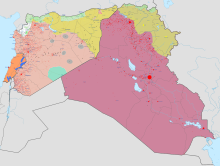This article needs to be updated. (February 2024) |
| Spillover of the Syrian Civil War | |||||
|---|---|---|---|---|---|
| Part of the Syrian civil war, Arab Spring, Arab Winter, War on Terror, and the War against the Islamic State | |||||
 Map of the military situation in Syria, Iraq, and Lebanon, as of October 2024. For the current military situation, click on one of the following links to a map template without shaded areas: here for Syria, here for Iraq, here for Lebanon, and here for all three in one map. | |||||
| |||||
Following the outbreak of the protests of Syrian revolution during the Arab Spring in 2011 and the escalation of the ensuing conflict into a full-scale civil war by mid-2012,[1] the Syrian Civil War became a theatre of proxy warfare between various regional powers such as Turkey and Iran. Spillover of the Syrian civil war into the wider region began when the Iraqi insurgent group known as the Islamic State of Iraq (ISI) started intervening in the conflict in 2012.
In 2012, ISI began transporting its fighters, arms and supplies to Syria. In April 2013, ISI renamed itself as the "Islamic State of Iraq and Levant" (ISIL), officially announcing its expansion into Syria. Throughout 2013, ISIL fought Syrian opposition groups, gaining control of numerous villages, towns and cities in eastern and northern Syria. In late 2013, ISIL launched its Anbar campaign into regions of Western Iraq and captured Fallujah in January 2014. In June 2014, ISIL captured vaste swathes of territory during its Northern Iraq offensive, culminating in the capture of Mosul. On 29 June 2014, the group renamed itself as the "Islamic State" (IS) and declared itself as a Caliphate.[2][3][4]
- ^ Charbonneau, Louis (13 June 2012). "Syria conflict now a civil war". Reuters. Archived from the original on 21 March 2017.
- ^ "FSA-ISIS fighting kills 51 on Syria-Iraq border". Al Arabiya English. 10 April 2014. Archived from the original on 19 October 2017. Retrieved 19 May 2020.
- ^ Karen Leigh. "For ISIS, Iraq's Spoils Could Tip Balance in Eastern Syria". United States: ABC News. Archived from the original on 14 April 2019. Retrieved 29 May 2015.
- ^ Myre, Greg (13 June 2014). "In One Map, The Dramatic Rise of the Islamic State Militants". NPR. Archived from the original on 20 April 2015. Retrieved 29 May 2015.